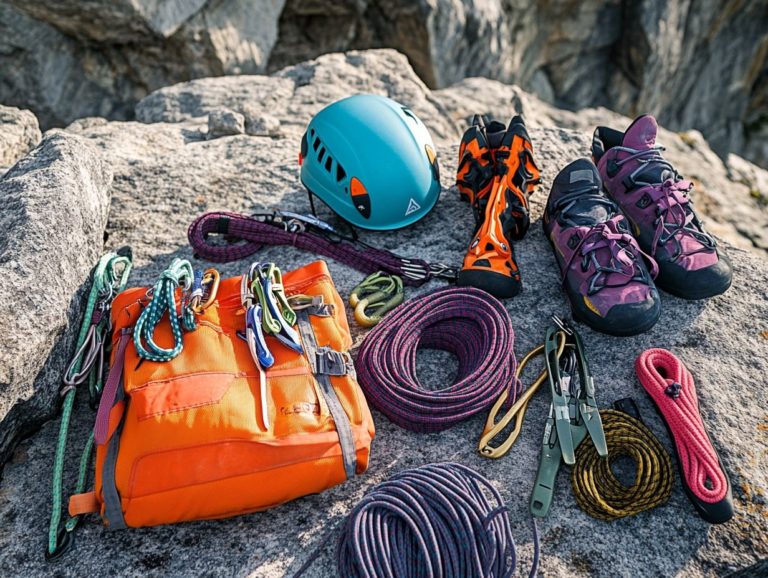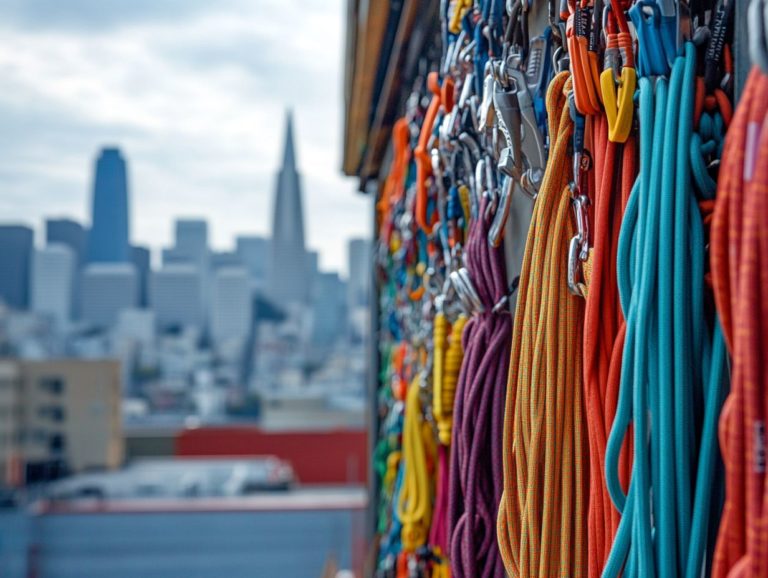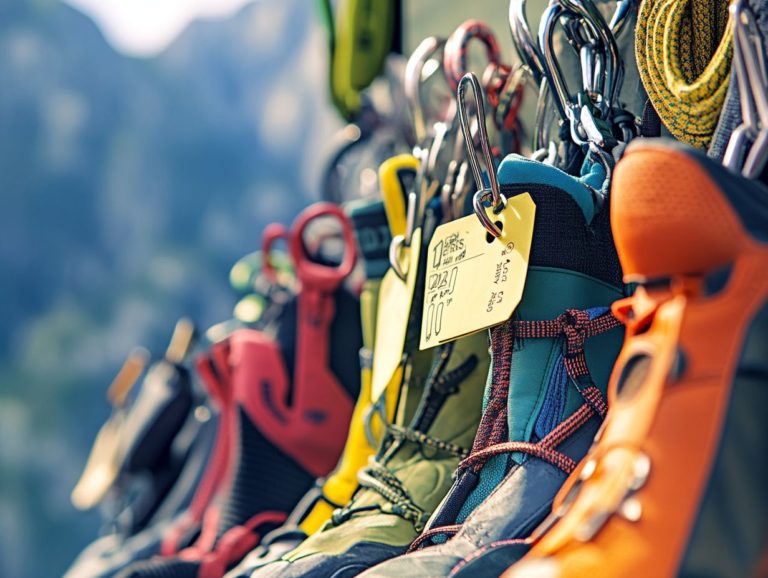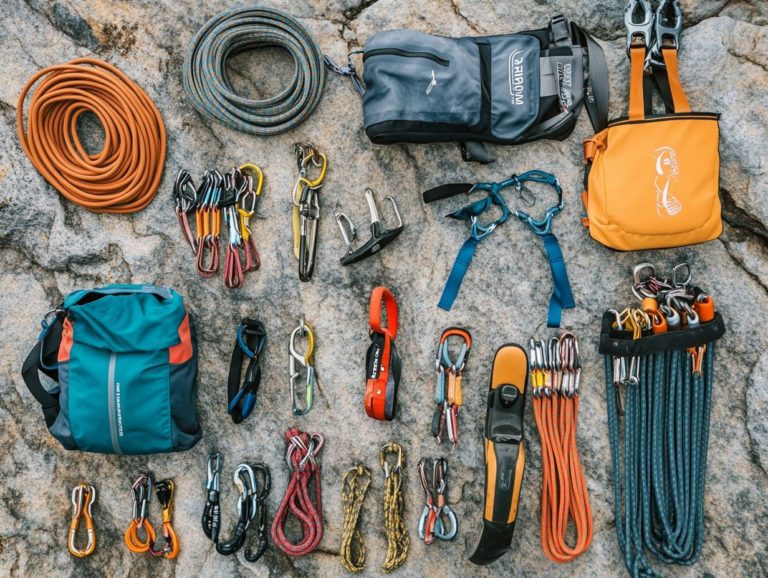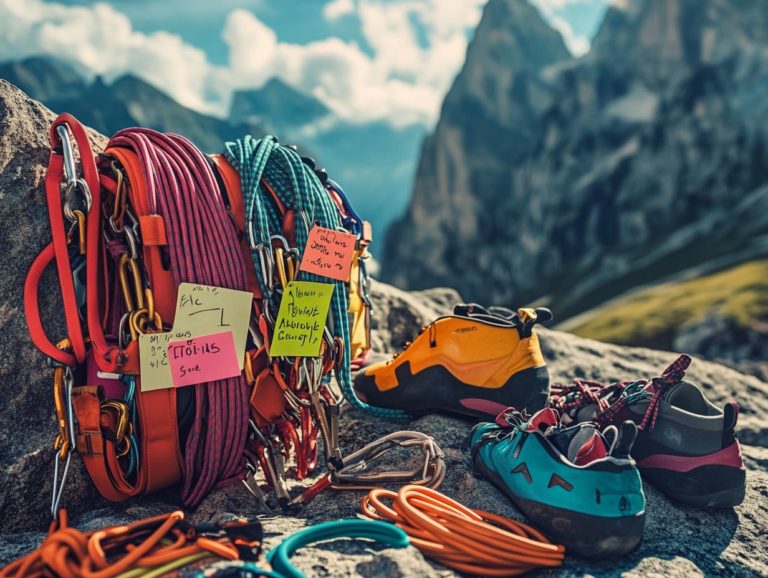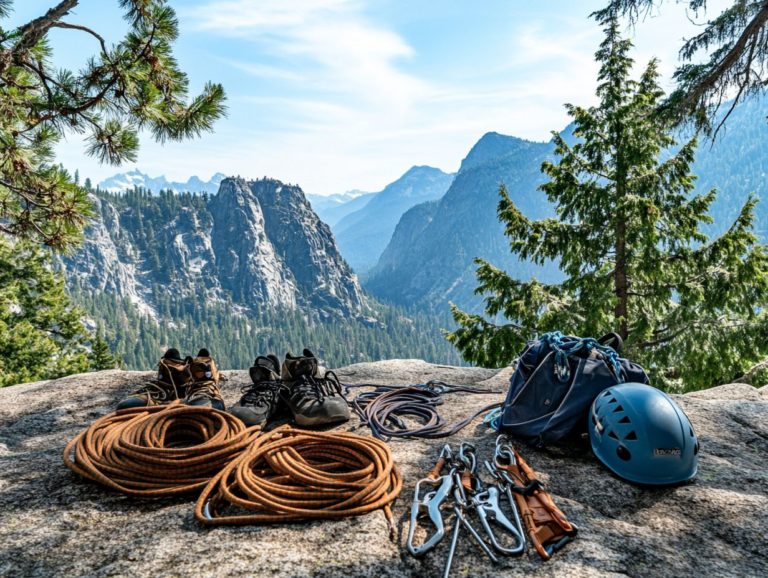Essential Climbing Gear for Sport Climbers
Are you preparing for an exhilarating climbing adventure? Whether you re a seasoned expert or just embarking on your climbing journey, having the right gear is absolutely vital for both your safety and performance.
This guide will walk you through the essential climbing equipment every sport climber should possess, from the ideal pair of climbing shoes to a dependable harness and everything that falls in between.
Each piece of gear will be examined, emphasizing its significance and function, so you can approach your next ascent with confidence and assurance.
Get ready to take your climbing experience to the next level!
Contents
- Key Takeaways:
- 1. Climbing Shoes
- 2. Harness
- 3. Chalk Bag and Chalk
- 4. Belay Device
- 5. Quickdraws
- 6. Rope
- 7. Helmet
- 8. Climbing Clothing
- 9. Carabiners
- 10. Climbing Backpack
- 11. GriGri or Other Assisted Braking Device
- 12. Nuts and Cams for Trad Climbing
- 13. Climbing Tape
- 14. Headlamp
- 15. First Aid Kit
- Frequently Asked Questions
- What is considered essential climbing gear for sport climbers?
- Do I need a specific type of harness for sport climbing?
- Why do I need climbing shoes for sport climbing?
- How long should my climbing rope be for sport climbing?
- Why do I need quickdraws for sport climbing?
- Is a helmet necessary for sport climbing?
Key Takeaways:
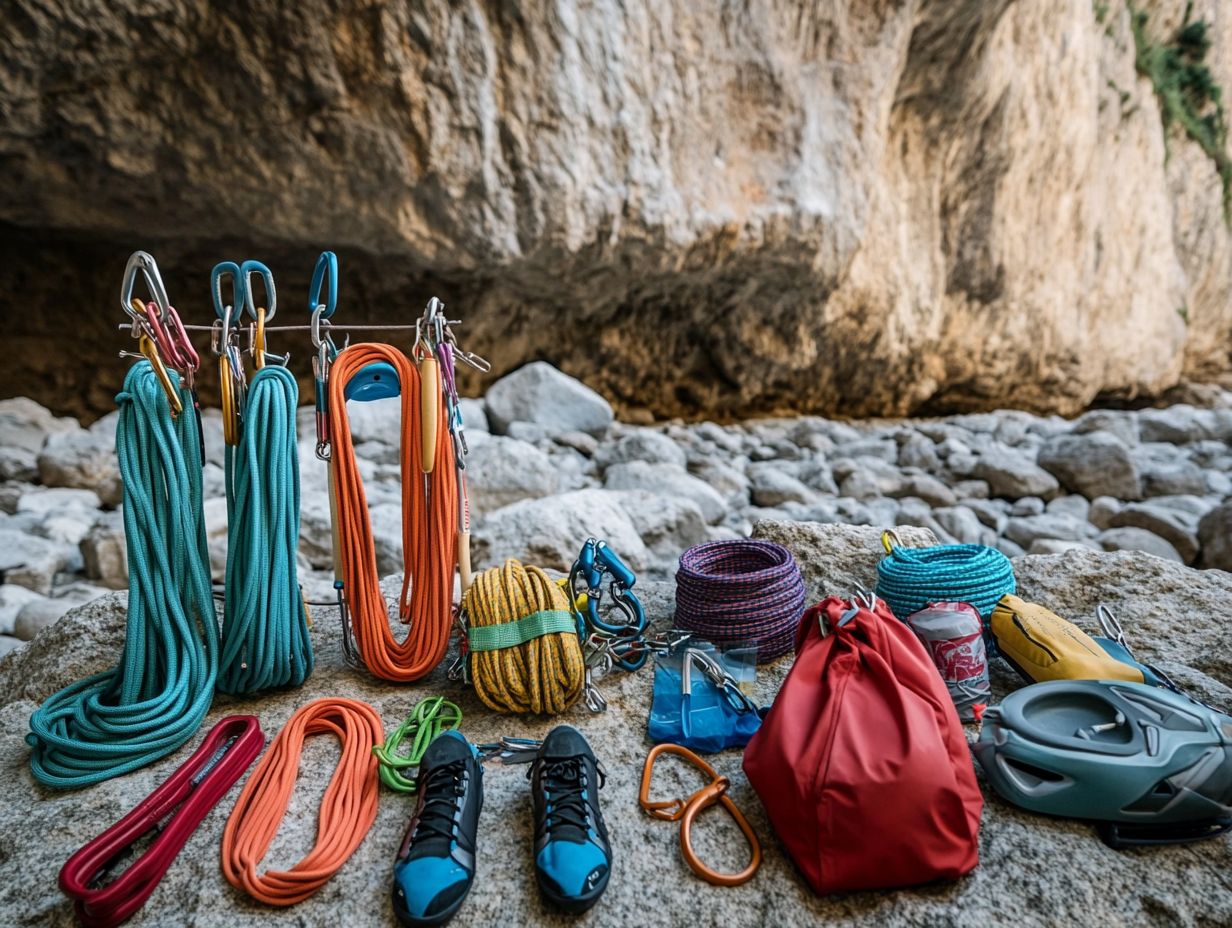
- Comfortable and well-fitted climbing shoes are essential for better grip and support while sport climbing.
- A harness that fits well and provides proper support is very important for safety and comfortable movement on the wall.
- Chalk and a chalk bag help prevent sweaty hands and improve grip, making them important gear for sport climbers.
1. Climbing Shoes
Climbing shoes are essential gear for any outdoor enthusiast, providing the precision and support you need for effective climbing. They truly are a cornerstone of your climbing kit.
A suitable pair enhances grip on various surfaces and ensures comfort during those long ascents. This can significantly impact your climbing techniques. The importance of fit cannot be overstated; a well-fitted shoe boosts your performance and minimizes the risk of injuries by providing vital support to your feet.
Technical features like special rubber and closure systems such as Velcro or laces maintain stability and help you adapt to different rock types. For beginners, selecting climbing shoes involves considering the type of climbing you intend to pursue and trying on multiple options to find the most comfortable fit.
- Shoes like the Five Ten Kirigami offer a versatile fit for various climbing styles.
- The La Sportiva Tarantulace combines durability and comfort, making it perfect for newcomers.
- The SCARPA Vapor S is designed for precision, catering to those eager to progress quickly.
Understanding these elements gives you the power to make informed choices that will elevate your climbing experience.
2. Harness
A climbing harness is an essential piece of safety equipment that connects you to the rope, ensuring your protection during outdoor climbing adventures.
With various types designed for different climbing styles, selecting the right harness is very important for both your performance and safety. Sport harnesses, typically lighter and featuring fewer gear loops, cater to single-pitch climbs where flexibility and ease of use take precedence. In contrast, trad harnesses offer extra padding and multiple gear loops, making them ideal for routes that demand more gear placements. For those interested in indoor climbing, check out the essential gear for indoor climbing.
If you’re tackling high-altitude ascents, alpine harnesses prioritize warmth and minimal weight. When choosing a harness, consider factors such as your intended climbing style and how well it fits to prevent discomfort, along with essential safety features like gear retention and load distribution. Your safety and comfort depend on making the right choice.
3. Chalk Bag and Chalk
A chalk bag, especially when paired with high-quality chalk like Metolius Super Chalk, becomes essential for maintaining your grip while climbing, particularly on those challenging routes.
You ll find a variety of chalk bags available, each tailored to fit specific climbing styles or personal preferences. For instance, semi-rigid bags allow you easy access to chalk while keeping their shape intact, whereas larger, deeper bags are perfect for sport climbers who require extra storage for different types of chalk.
Opting for specialized chalk brands can significantly boost your performance. Take Black Diamond, for example; their unique formulas work wonders in reducing moisture and enhancing grip. Don t forget to dust your hands with chalk before tackling your routes this simple step can improve your overall grip and confidence, making for a smoother ascent.
4. Belay Device
A belay device is critical for controlling the rope. It ensures your safety during climbs.
Consider popular options like the Edelrid Mega Jul and Petzl GriGri. Each offers unique functionalities tailored to different needs.
These devices are not just accessories; they are vital for your safety system. They catch falls and manage descent with finesse.
Understanding how these mechanisms work is crucial for climbers who take their safety seriously.
For instance, the assisted braking features in devices like the GriGri help slow down your fall, making climbs safer. Manual devices like the Mega Jul require more active engagement from you as the belayer, creating a more intimate climbing experience.
By comparing these options, you can make informed decisions. Elevate your safety and optimize your performance on the rock face!
5. Quickdraws
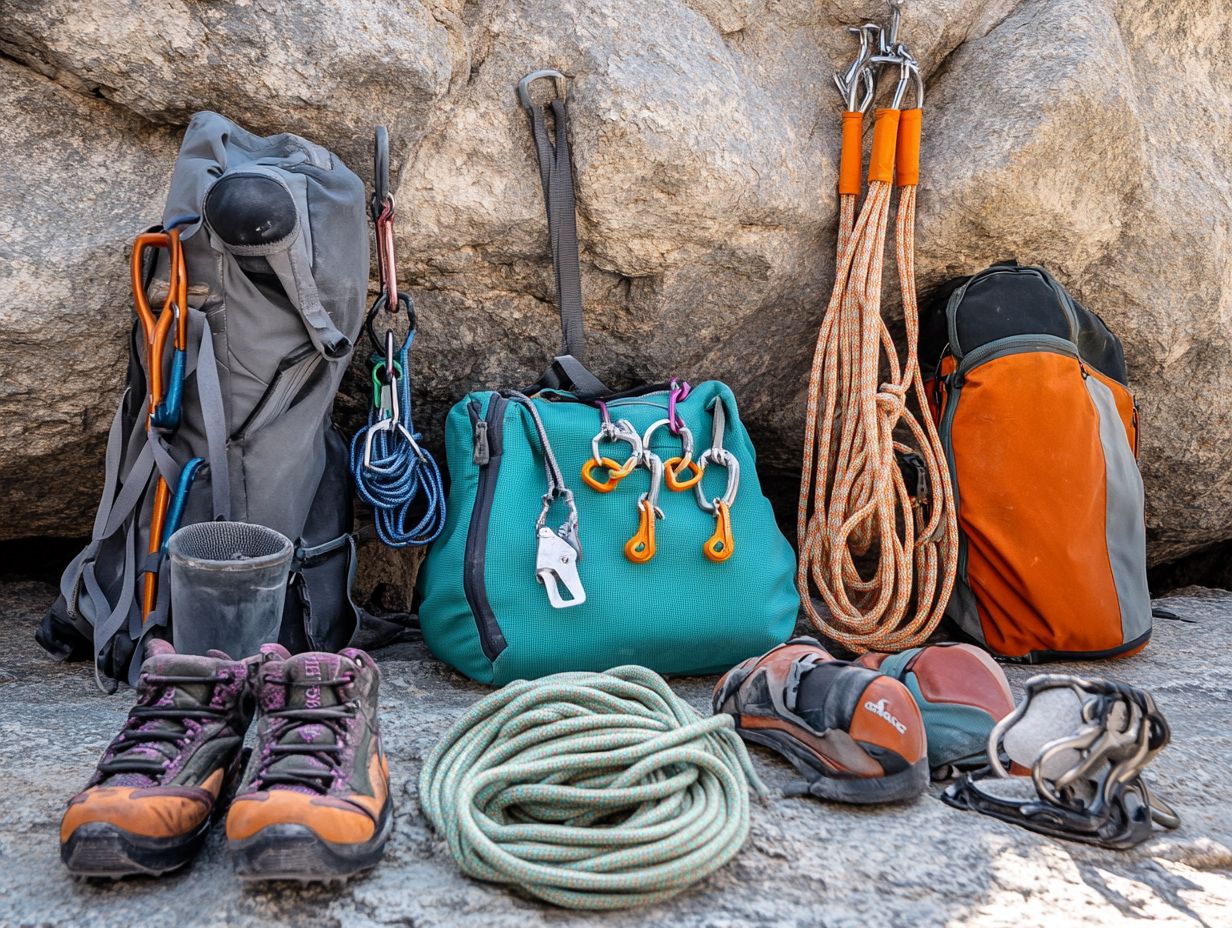
Quickdraws are critical in sport climbing. They serve as the vital link between your rope and protection points.
Take the Metolius Bravo II Wiregate Quickdraws, for example; they provide reliability and ease of use. This makes them a great choice.
These versatile tools enhance your safety and efficiency while climbing. They absorb impact forces and enable smoother movement along your route.
With a variety of brands and designs available like wiregate and solid-gate options you can find quickdraws tailored to your climbing scenarios and preferences.
Lightweight quickdraws are perfect for alpine climbs, where every ounce counts. In contrast, robust models are ideal for sport routes that demand greater durability.
Don t wait! Choosing the right quickdraw is essential for your safety and can skyrocket your climbing performance!
6. Rope
Choosing the right climbing rope is essential for your safety and performance. Options like the Edelrid NEO 3R 9.8 offer exceptional durability and handling.
Understanding the distinctions between dynamic and static ropes is invaluable. Dynamic ropes are designed to stretch when you fall, making them the go-to choice for lead climbing and fall protection.
Static ropes exhibit minimal stretch and excel in scenarios like rappelling, hauling gear, or using fixed lines where stability is paramount.
Caring for your ropes is crucial. Using specialized soap for washing and ensuring they re completely dry before storage can significantly prolong their lifespan.
Consider a rope bag, such as the Metolius Ropemaster HC. This not only protects your rope from wear and tear but also shields it from dirt and moisture.
Preserve your rope s integrity and reliability for when you need it most!
7. Helmet
A climbing helmet is an essential piece of safety gear. It protects you from falling debris and impacts.
Models like the Black Diamond Half Dome Helmet combine comfort and durability. You ll be well-prepared for your ascent.
When climbing, the importance of wearing a helmet cannot be overstated. It shields you from unforeseen rockfalls and provides crucial protection in case of an accidental fall.
As you gear up, consider key features like ventilation for breathability during intense climbs, a snug fit to ensure stability, and lightweight materials that reduce neck strain.
These aspects enhance your overall climbing experience and safeguard you against various risks, including impacts from equipment and environmental hazards.
Ultimately, investing in a quality helmet is crucial for enhancing your safety and boosting your confidence on the rock.
8. Climbing Clothing
Climbing clothing is essential for your comfort and safety during outdoor climbing sessions. These garments are designed with specialized fabrics that can handle the demands of the sport.
They often feature moisture-wicking materials to keep you dry and lightweight stretch fabrics that allow for a full range of motion. The layering system is key; it enables you to adjust based on changing weather conditions. Start with a base layer, the first layer of clothing that helps wick moisture away from your skin, for moisture management. Next, add an insulating mid-layer for warmth, and finish with a durable outer layer to shield you from wind and rain.
Knee pads or climbing shorts crafted from abrasion-resistant materials can enhance your mobility while providing much-needed protection. If you’re heading into colder climates, thermal jackets and insulated gloves become invaluable, keeping you safe and ready for your next adventure!
9. Carabiners
Carabiners, especially locking types like the Petzl Sm D, are critical for securing your gear and ensuring safety during your climbs.
These versatile tools come in various shapes and sizes, each tailored for distinct climbing scenarios. For example, oval carabiners excel in belaying, while D-shaped ones are often favored for their superior strength and efficiency in load distribution.
When selecting a carabiner, consider the specific type of climbing you plan to do, be it sport, trad, or alpine. Each type demands unique features. Your top priority is safety, so pay close attention to the carabiner’s strength rating and locking mechanism, which refers to how the carabiner closes and holds gear. For a comprehensive list of the best equipment, check out the top climbing gear for rock climbers.
You ll also want to decide between automatic, screw-lock, or twist-lock options based on your route’s demands and your experience level.
10. Climbing Backpack
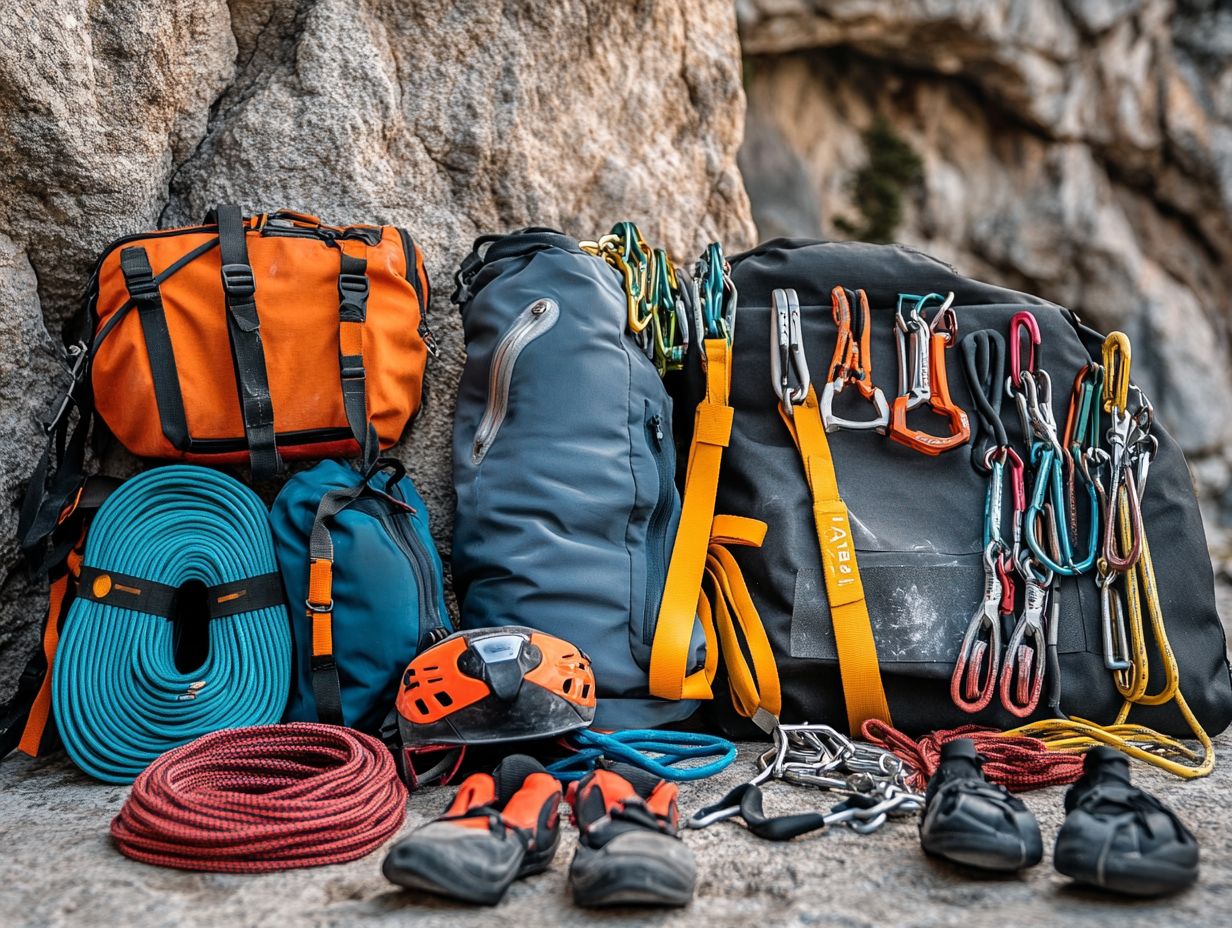
A climbing backpack, like the Osprey Zealot 45, is crafted to carry all your essential outdoor gear, ensuring you have everything you need for a successful expedition.
Choosing the right climbing backpack is vital, as it directly influences your performance and comfort during the ascent. Look for a pack that boasts durability to withstand the rugged outdoor environment while remaining lightweight. For those tackling challenging routes, consider the best climbing gear for multi-pitch routes. This helps you maintain your mobility and endurance.
Features that promote effective organization, such as multiple pockets and attachment points, allow you to access your gear with ease essential when every second counts in challenging situations. By understanding these key attributes, you can significantly enhance your overall climbing experience, making this selection a crucial step in your preparation process.
11. GriGri or Other Assisted Braking Device
The Petzl GriGri stands out as a top-tier assisted braking device, elevating safety during your climbs with effortless rope handling and controlled lowering.
This innovative tool grants you a level of control that traditional belay methods simply can’t match. It features a sophisticated mechanical system that engages when a climber falls, automatically locking the rope and significantly reducing the risk of accidents.
You ll find these devices particularly invaluable in situations with unexpected weight shifts, such as lead climbing or those moments when fatigue sets in. The ease of use and swift response time lighten your mental load as the belayer, allowing you to concentrate entirely on the climber s safety.
In the end, assisted braking devices represent a modern solution that enhances your climbing experience and reinforces your confidence on the rock face.
12. Nuts and Cams for Trad Climbing
Nuts and cams are crucial gear for trad climbing, offering reliable protection across various rock types and ensuring your safety on unpredictable routes.
Understanding their function and placement is vital for climbers of all skill levels; these devices can be the difference between a safe climb and a dangerous fall—choose wisely! For more insights, check out the top 10 must-have climbing gear accessories. Consider the specific climbing scenario: narrow cracks typically call for nuts, while wider gaps might require the versatility of cams.
Becoming familiar with the rock structure and understanding the types of protection needed will boost your confidence and help minimize risks. Properly employing these tools not only secures your climb but also deepens your appreciation for the nuances of each climbing challenge.
13. Climbing Tape
Climbing tape is a versatile tool in your climbing toolkit. It protects your hands and reinforces your gear.
Understanding its uses can elevate your performance and safety. When tackling challenging routes, the right taping technique prevents skin abrasions and blisters.
When your slings or harnesses start to wear out, climbing tape becomes a reliable temporary fix. Apply it snugly but not too tightly around your fingertips or injury-prone areas. Always keep a roll on hand for quick repairs it can greatly enhance your climbing experience.
14. Headlamp
A headlamp is a critical piece of outdoor gear for any climber, providing hands-free illumination during those early morning or late evening ascents.
The right headlamp combines several essential features that enhance your safety and performance in challenging conditions. A high brightness level delivers light that slices through darkness, illuminating rocky paths and ensuring every foothold is visible.
Battery life is crucial; as you tackle lengthy climbs, having a reliable power source can make a significant difference. Durability is equally important an impact-resistant and weatherproof design ensures your headlamp can endure the demands of outdoor adventures.
For optimal use, remember to switch on your headlamp before sunset. Avoid shining it directly into the eyes of your fellow climbers, maintaining courtesy while ensuring everyone on your team has the visibility they need.
15. First Aid Kit
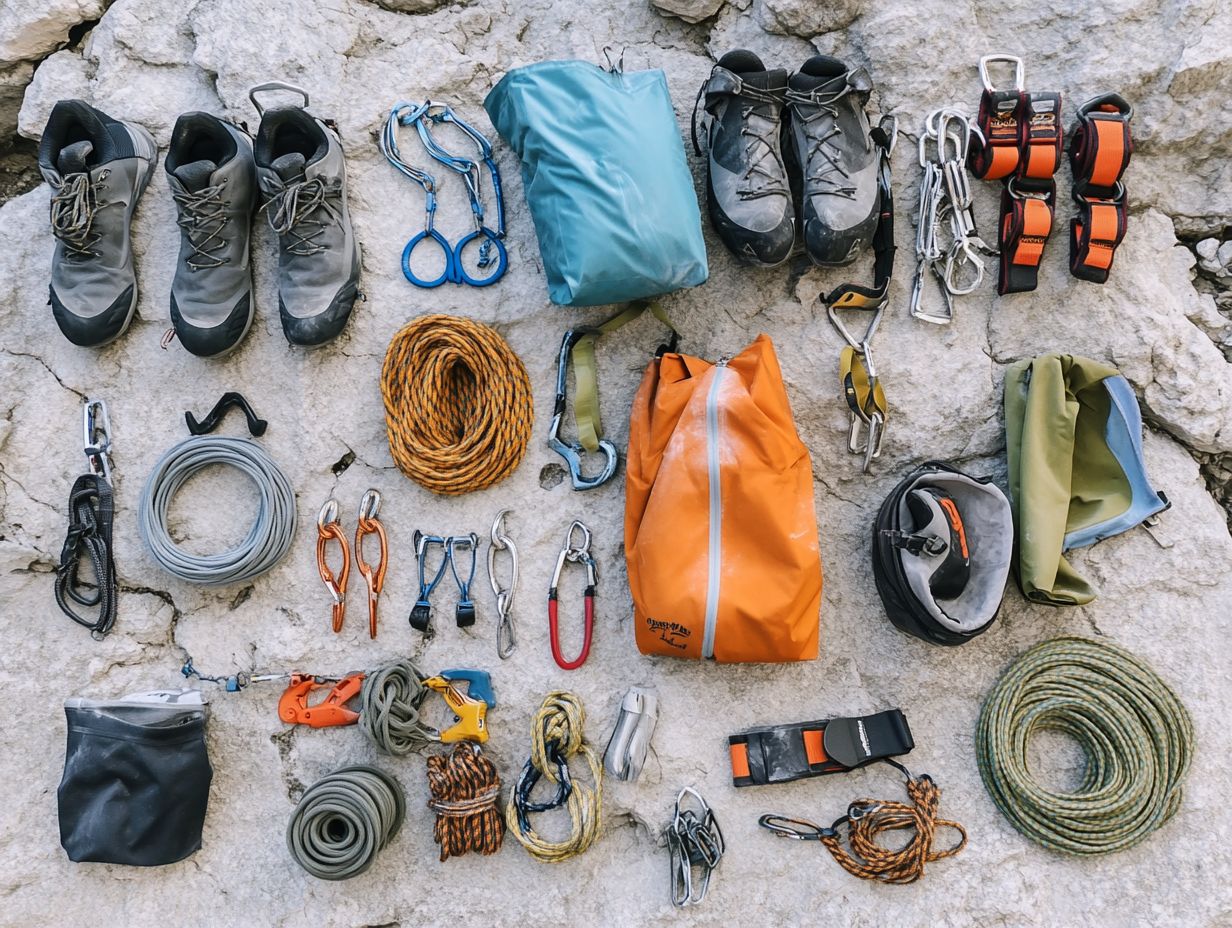
A well-stocked first aid kit is your safety net in the wild! It helps you respond quickly to injuries during your adventures.
Equipping yourself with crucial items like adhesive bandages, antiseptic wipes, gauze pads, and a multi-tool can mean the difference between a minor mishap and a serious issue. In remote climbing locations where immediate medical assistance is hours away, having these supplies ready empowers you to tackle cuts, scrapes, or even more significant injuries. Additionally, investing in the best climbing gear for alpine climbs can enhance your safety and performance on the mountain.
Including extras like pain relievers, a triangular bandage, and a splint helps you manage discomfort and stabilize injuries until help arrives. Ultimately, the importance of being prepared cannot be overstated; it enhances your safety and elevates the entire climbing experience.
Frequently Asked Questions
What is considered essential climbing gear for sport climbers?
Essential climbing gear for sport climbers includes a harness, climbing shoes, a rope, quickdraws, a chalk bag, and a helmet. These are the basic items needed for a safe and successful climb.
Do I need a specific type of harness for sport climbing?
Yes, it is recommended to use a harness specifically designed for sport climbing. These harnesses typically have more padding and are lighter weight, making them more comfortable for long climbs and falls.
Why do I need climbing shoes for sport climbing?
Climbing shoes provide the necessary grip and support for both indoor and outdoor sport climbing. They have a sticky rubber sole that helps grip onto small holds and edges, making it easier to climb.
How long should my climbing rope be for sport climbing?
The standard length for a sport climbing rope is between 60 to 70 meters. This length allows for most routes to be climbed safely. However, it is important to always check the route length and bring a longer rope if needed.
Why do I need quickdraws for sport climbing?
Quickdraws are used to connect the rope to the bolts on the climbing wall. They consist of two carabiners connected by a sling, making it easy to clip the rope while climbing. They are specifically designed for sport climbing routes and are essential for safe and efficient climbing.
Is a helmet necessary for sport climbing?
Want to stay safe on your climbing adventures? Don t skip the helmet!
Absolutely! Wearing a helmet is essential for sport climbing.
While sport climbing usually lacks loose rocks, risks still exist. Accidental falls or dropped gear can lead to injuries.

